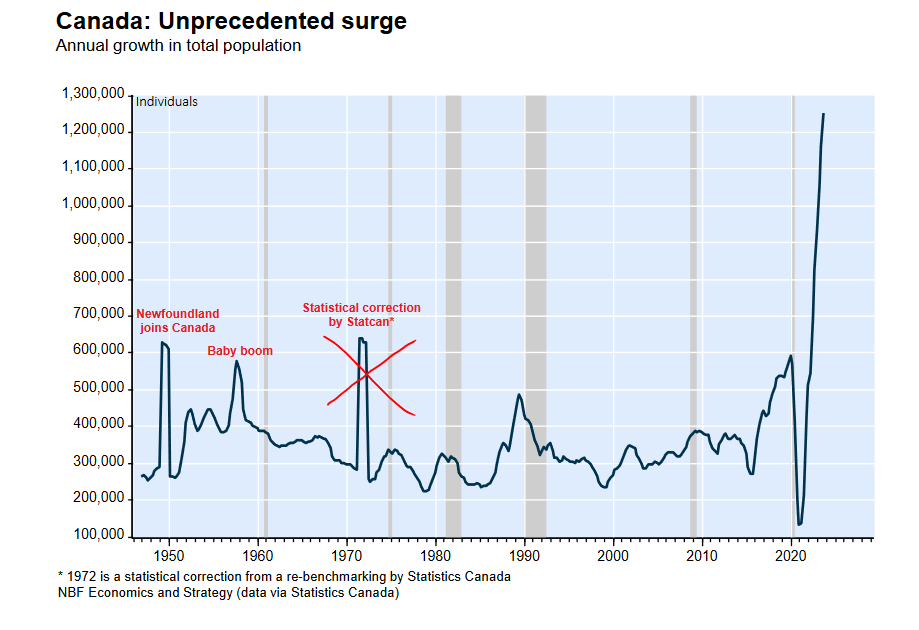The Good Ship Canada at 40 Million: Where Are We Headed?
Congratulations, Canada! On June 16, right on time for Canada Day, you reached a population of 40 million. This is no mean feat for a country whose total fertility rate is 1.4 children per woman and has been below the replacement level of 2.1 since 1971, when its population was under 22 million, all while the maternal age at delivery has been rising. One could have expected a population of well under 30 million.
Canada’s population growth rate leaves the rest of the G7 countries in the dust and now even tops that of most developing countries. The total fertility rates of many middle- and low-income countries have fallen or are rapidly falling toward the replacement level and their annual growth rates with it; the latter are still driven mainly by the demographic momentum of a high percentage of young people.
Canada, however, is going in the opposite direction. In 2022, over one million people – permanent and non-permanent residents – entered Canada and immigration accounted for 95.9% of Canada’s population growth that year. This put it in the top twenty for annual growth rate; nearly all of the countries that “outperformed” it are in Africa. In fact, Canada’s growth rate in 2022 of 2.7% annually tops the average African growth rate of 2.4%. The global average is 0.88%.
As one commentator on PIC’s tweet about the 40 million milestone said, “Yay! Third World status is within our reach!”
Canada’s Total Fertility Rate Plummets as Its Population Surges
Aside from a fertility bump with a peak of about one child per woman during the post-war baby boom of the mid-1940s to mid-1960s, Canada’s total fertility rate has been falling steadily since 1860 from almost six children per woman to about 1.4 today. But it is growing at third world rates because of its policy of high immigration. The graphs below show the opposing directions of Canada’s fertility rate and population growth.


A Motto to Promote Political Objectives: “We Are a Land of Immigrants”
While government and media frequently inform Canadians that theirs is a land of immigrants, the reality is that for most of its history, the biggest contributor to Canada’s population growth was natural increase. This only began to change in 1990, when the Progressive Conservative government of Brian Mulroney initiated a policy of bringing in a quarter of a million people each year, regardless of economic conditions. This policy of mass immigration was followed by every government, Conservative or Liberal, since then. It was ramped up under Justin Trudeau’s Liberal government in 2017, with even higher targets announced in November 2022, although in reality all targets were blown out of the water by the actual record-breaking number of newcomers who entered that year.
The graph below shows the percent population growth that occurred in the period between the decennial censuses of 1851 to 2011, with projections to 2046. The green bars show the percent contribution to growth of natural fertility. The blue bars show the contribution of immigration. Note that in five censuses (1861, 1871, 1881, 1891, and 1931), immigration was found to have made a negative contribution to growth (i.e., more people left Canada than immigrated to it). The pale blue bar of the 1951 census represents the one-time contribution to Canada’s population of Newfoundland joining the Dominion in 1949.

Interestingly, the message that “Canada is a land of immigrants” became ubiquitous only after the government launched its policy of mass immigration. This aging boomer does not recall it being relentlessly promoted before the 1990s. Today, Canadians receive the message overtly via radio, TV, and even billboards, but also indirectly as a theme incorporated into advertisements and infomercials.
I took the picture below at Toronto’s Pearson International Airport on June 19, 2019. It was one in a series of stylized images of recent immigrants, interspersed with other advertisements, on an electronic display board in a waiting lounge.

Canada’s Incoherent Policies in a Nutshell
The Trudeau government is simultaneously pursuing two contradictory goals. They can be summarized as follows:
Goal 1: Reducing energy consumption and greenhouse gas emissions. In March 2022, Environment Minister Steven Guilbeault announced that the government wants a 42% reduction in emissions from the oil and gas sector by 2030 and would spend an additional $9.1 billion (CAD) to meet that target. The government is also pressuring farmers to cut emissions from fertilizer use by 30% below 2020 levels by 2030, even as population growth is rapidly reducing the amount of high-quality farmland. During the 2021 election campaign, Trudeau set a target of net zero emissions by 2050. A Royal Bank of Canada report estimated an overall cost of two trillion dollars to government and businesses to reach that target.
Goal 2: Growing the population to keep the economy growing. Canada is using population growth as a tool in its misguided goal of growing the overall size of the economy. Inconveniently, Canada is per capita among the highest GHG emitters in the world. The claim that densification will prevent sprawl and that increased efficiencies in transportation and energy use will compensate for population growth with regard to GHG emissions has yet to be substantiated.
The reality is that Canada’s population growth is creating an unprecedented housing crisis and reducing its capacity to feed itself, as well as driving up GHG emissions. Between 1990 and 2019, Canada’s population grew by 9.9 million. During that time, its annual GHG emissions increased by about 130 Mt CO2 equivalent, although its per capita emissions were much the same (having reached a peak earlier in the 2000s). The increase in emissions was due to population growth. A US study published in 2008 showed that the average newcomer to the US increased their GHG emissions by a factor of four. John Meyer, president of Canadians for a Sustainable Society, made similar calculations for Canada for 2015, and came up with a factor of 4.2 (personal communication).
Is it even possible that neither the prime minister nor anyone in his cabinet has noticed that the second goal of rapidly growing the population makes the first of drastically cutting greenhouse gas emissions impossibly difficult, in addition to creating multiple other problems? What restrictions and taxes will be imposed on Canadians as Canada’s population surges while the government clamps down on GHG emissions?
Biophysical Realities Trump Green Rhetoric
Canada has good reasons for being a global leader in GHG emissions. It has a cold climate and goods and people travel long distances. Heating and transportation are among the highest fossil fuel-consuming sectors. Canada’s population boom is leading to a massive amount of construction and both the construction industry and the operation of buildings are energy intensive. Every newcomer to Canada, no matter how densely packed into a 15-minute city, will contribute to its emissions. Nor is settling new arrivals in our uninhabited “vast open spaces,” even if feasible, a solution. They would need fuel to keep warm and food to eat, both of which would have to be transported, almost certainly with the use of fossil fuels. Electric vehicles rapidly lose range at cold temperatures.
Canada’s record in reducing its GHG emissions has yet to match its rhetoric. It is the only G7 country whose emissions rose between 2015 (the year Trudeau came to power) and 2019. Naturally, Trudeau blamed the previous Conservative government which in 2011 withdrew from the Kyoto protocol, the precursor to the 2015 Paris agreement. Trudeau also claimed that four years of US climate change skepticism under President Donald Trump held Canada back. That is amusing, because the primary driver of rising GHG emissions in both the US and Canada is population growth. But the US cut back immigration, especially illegal immigration, under Trump (remember the Remain in Mexico policy?), while Canada pursued ever greater legal immigration and ignored the gaping hole at Roxham Road through which close to 100,000 people entered Canada illegally. Consequently, between 2016 and 2019, total emissions under Trump grew by only 0.6%, while Canada’s emissions under Trudeau grew by 3.4%.
The Century Initiative: The Hidden Captain of the Good Ship Canada?
The modern economic paradigm is based on growth. A growing GDP is the metric of a successful economy, and the GDP will grow along with the population unless the standard of living is falling. But a GDP that grows simply because the population is growing does not increase per capita wealth nor general well-being. Nevertheless, immigration has been used as a tool to drive simple population growth in Canada for over three decades. Not only has this not increased the per capita GDP, it has widened the gap between the rich and poor, and those struggling to make ends meet constitute an increasing part of the population. Current immigration levels have created an artificial housing shortage and driven house prices beyond the reach of working Canadians. Municipalities are being forced to densify and people are paying exorbitant rates to live in shoeboxes. Farmland and wildlife habitat are being lost to urbanization, which also threatens water resources.
However, Canadians who disagree with their government’s policy of mass immigration, whether for economic, social, or environmental reasons, run the risk of being labelled anti-immigrant, populist, or xenophobic. This has had the effect of stifling a reasoned public discussion about immigration in Canada, which has served the interests of profiteers of growth, but not of working Canadians.
Who is beating the drum to which Canada’s population (immigration) policy marches? It’s becoming more and more obvious that federal government is following the script of the Century Initiative. The CI was founded in 2011 by Dominic Barton and Mark Wiseman with the purpose of promoting a Canadian population of 100 million by 2100. Barton worked for 33 years for McKinsey & Company before leaving as a senior partner in July 2018. The following month, McKinsey landed a lucrative contract with Immigration, Refugees and Citizenship Canada. At the time of CI’s founding , Wiseman was a Senior Managing Director at BlackRock and chairman of its Alternative Investment division, which included investments in real estate. He is currently the chair of the Alberta Investment Management Corporation.
In December 2015, two months after Trudeau’s election as prime minister, his government created the Advisory Council on Economic Growth. Both of the Century Initiative founders sat on its board, and Barton was appointed chair in February 2016. The Advisory Council’s first report was released in October 2016 and called for massively increasing immigration levels to 450,000 annually. Subsequent reports all promoted the same message, which unsurprisingly aligned perfectly with the goal of the Century Initiative.
The third and final report of the Advisory Council on Economic Growth was released on December 1, 2017, two months after then immigration minister Ahmed Hussen announced a “new normal” of at least 300,000 immigrants annually. Current immigration minister Sean Fraser’s new normal, announced in November 2022, was to top 500,000 annually by 2025. But, as noted earlier, the actual number of new arrivals in 2022 was twice that number.
When it comes to meeting the Century Initiative’s targets, the government is on track to “exceed expectations.” But from whom is it expecting to get a gold star?
A Postnational Country Has No Need for Citizens
Driving Canada’s population growth through immigration produces clear winners and losers. The losers are most working Canadians, including the ones who immigrated here for a better life, many of whom are struggling despite high levels of education. The environment, farmland, and biodiversity are losers too. The winners are speculators, developers, mortgage providers and some businesses, as well as politicians. But the current profiteers of growth will be long gone by the time 2100 comes around. So why the target of 100 million by that date? Are targets even being set in Canada or is there a supranational plan?
Such questions may strike some as conspiracy talk, but at this point being open to all possibilities in trying to connect the dots seems reasonable. Justin Trudeau told The New York Times in 2015 that Canada was the first “postnational state” with no “core identity” or “mainstream.” Is that in fact what he is aspiring to create? Trudeau, many members of his cabinet, and both founders of the Century Initiative are tied to the World Economic Forum, which promotes globalization in the economic and governance spheres. There is nothing the WEF and international corporations would like more than the free flow of goods, labour and money. Citizens with national attachments are an impediment to creating this commercial utopia of rootless consumers. And how can one be attached to a postnational country with no core identity?
Whatever the reality, Canadians need to start asking questions about why their country is being steered to a destination of 100 million which gives them no obvious benefits and burdens them with many obvious costs.
Editor’s note: This article was originally published on Population Institute Canada’s website (populationinstitutecanada.ca) on May 17th, 2023. It is republished on Dominion Review with permission of the author.
All content on this website is copyrighted, and cannot be republished or reproduced without permission.
Share this article!




The truth does not fear investigation.
You can help support Dominion Review!
Dominion Review is entirely funded by readers. I am proud to publish hard-hitting columns and in-depth journalism with no paywall, no government grants, and no deference to political correctness and prevailing orthodoxies. If you appreciate this publication and want to help it grow and provide novel and dissenting perspectives to more Canadians, consider subscribing on Patreon for $5/month.
- Riley Donovan, editor